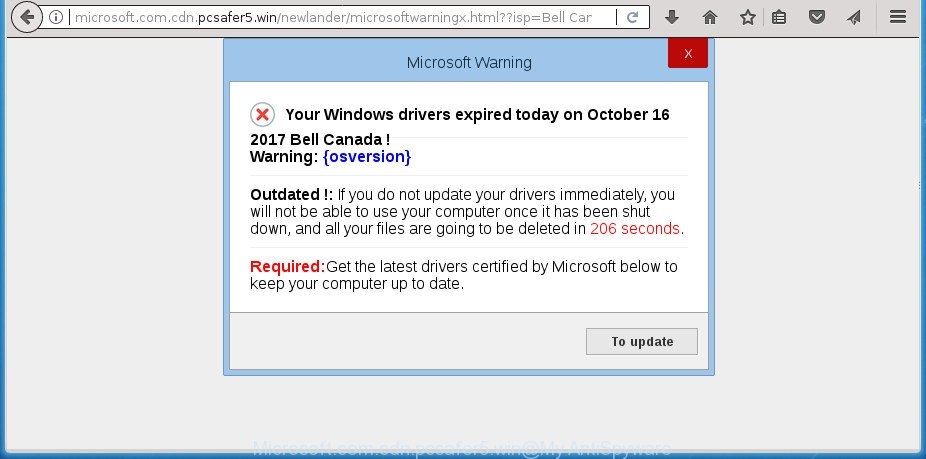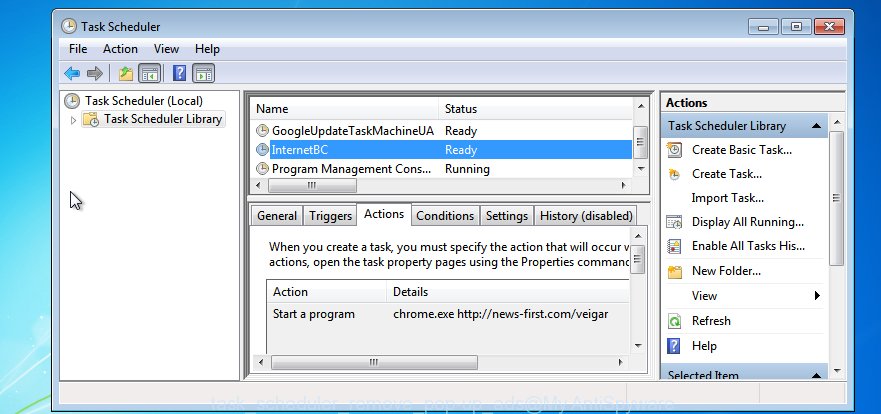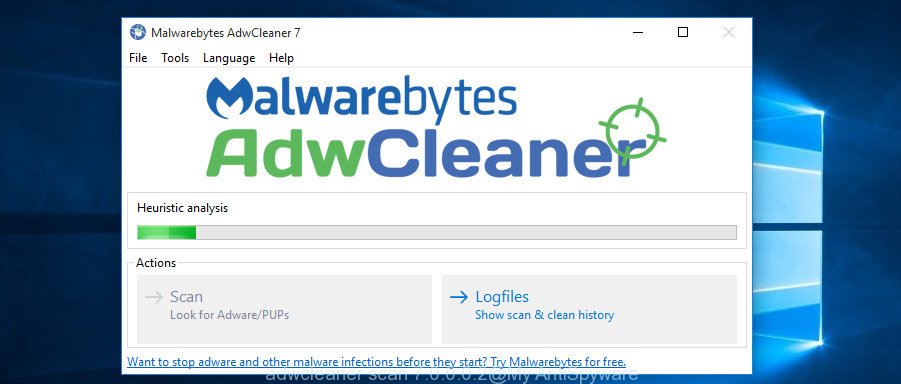The Microsoft.com.cdn.pcsafer5.win is an one of the many misleading web-sites that created in order to trick you into installing an questionable software. If your browser constantly displays the Microsoft.com.cdn.pcsafer5.win fake warnings, then your computer has become a victim of the unwanted software from the adware (also known as ‘ad-supported’ software) family. Most commonly the ‘ad supported’ software was set on your computer without your consent. Because, the adware is often used to open lots of annoying pop-up ads within the Google Chrome, Mozilla Firefox, MS Edge and Internet Explorer’s screen. As, the advertisers don’t disdain to use any methods to promote their software and attract new users. Below we explain how to delete ‘ad supported’ software and thus delete Microsoft.com.cdn.pcsafer5.win undesired popup from your web browser.

Microsoft.com.cdn.pcsafer5.win shows fake warnings
It’s probably that you might be bothered with the ‘ad supported’ software which cause misleading Microsoft.com.cdn.pcsafer5.win fake alerts to appear. You should not disregard this unwanted software. The adware might not only open undesired ads, but reroute your web browser to shady web pages. What is more, the adware can analyze your browsing, and gain access to your personal info and, subsequently, can use it for marketing purposes. Thus, there are more than enough reasons to delete Microsoft.com.cdn.pcsafer5.win popup from your computer.
The adware often modify all browser shortcuts that located on your Desktop to force you visit some undesired ad pages. As a result, your web-browser can still redirect you to an undesired ad web page despite your machine is actually clean of adware and other malicious software.
Therefore it’s very important to follow the few simple steps below ASAP. The steps will assist you to delete adware as well as clean your personal computer from the Microsoft.com.cdn.pcsafer5.win pop up warnings. What is more, the tutorial below will allow you get rid of other harmful software such as unwanted toolbars and browser hijackers, that can be installed onto machine along with the adware.
Remove Microsoft.com.cdn.pcsafer5.win popup warnings
In the tutorial below we will have a look at the ad-supported software and how to remove Microsoft.com.cdn.pcsafer5.win from Chrome, FF, Microsoft Edge and Internet Explorer web-browsers for Windows OS, natively or by using a few free removal utilities. Certain of the steps below will require you to exit this web-site. So, please read the step by step instructions carefully, after that bookmark or print it for later reference.
To remove Microsoft.com.cdn.pcsafer5.win, follow the steps below:
- How to delete Microsoft.com.cdn.pcsafer5.win pop-up without any software
- Delete Microsoft.com.cdn.pcsafer5.win related apps through the Control Panel of your computer
- Delete unwanted Scheduled Tasks
- Delete Microsoft.com.cdn.pcsafer5.win popup warnings from IE
- Remove Microsoft.com.cdn.pcsafer5.win popup scam from Google Chrome
- Remove Microsoft.com.cdn.pcsafer5.win from Mozilla Firefox by resetting web browser settings
- Disinfect the web-browser’s shortcuts to remove Microsoft.com.cdn.pcsafer5.win redirect
- Run free malware removal tools to completely remove Microsoft.com.cdn.pcsafer5.win pop up warnings
- How to block Microsoft.com.cdn.pcsafer5.win fake alerts
- How was popup adware installed on system
- Finish words
How to delete Microsoft.com.cdn.pcsafer5.win pop-up without any software
The useful removal steps for the Microsoft.com.cdn.pcsafer5.win pop up scam. The detailed procedure can be followed by anyone as it really does take you step-by-step. If you follow this process to remove Microsoft.com.cdn.pcsafer5.win fake alerts let us know how you managed by sending us your comments please.
Delete Microsoft.com.cdn.pcsafer5.win related apps through the Control Panel of your computer
The process of adware removal is generally the same across all versions of Windows OS from 10 to XP. To start with, it is necessary to check the list of installed programs on your PC and remove all unused, unknown and suspicious programs.
Windows 8, 8.1, 10
First, press the Windows button
Windows XP, Vista, 7
First, press “Start” and select “Control Panel”.
It will show the Windows Control Panel as on the image below.

Next, click “Uninstall a program” ![]()
It will show a list of all applications installed on your system. Scroll through the all list, and remove any suspicious and unknown applications. To quickly find the latest installed programs, we recommend sort software by date in the Control panel.
Delete unwanted Scheduled Tasks
If the intrusive Microsoft.com.cdn.pcsafer5.win web page opens automatically on Windows startup or at equal time intervals, then you need to check the Task Scheduler Library and delete all the tasks that have been created by ‘ad-supported’ apps.
Press Windows and R keys on the keyboard at the same time. This shows a prompt that called Run. In the text field, type “taskschd.msc” (without the quotes) and click OK. Task Scheduler window opens. In the left-hand side, press “Task Scheduler Library”, as displayed on the screen below.

Task scheduler
In the middle part you will see a list of installed tasks. Please select the first task, its properties will be show just below automatically. Next, press the Actions tab. Pay attention to that it launches on your system. Found something like “explorer.exe http://site.address” or “chrome.exe http://site.address”, then remove this harmful task. If you are not sure that executes the task, check it through a search engine. If it’s a component of the malicious apps, then this task also should be removed.
Having defined the task that you want to delete, then click on it with the right mouse button and select Delete as on the image below.

Delete a task
Repeat this step, if you have found a few tasks that have been created by ‘ad-supported’ program. Once is done, close the Task Scheduler window.
Delete Microsoft.com.cdn.pcsafer5.win popup warnings from IE
In order to restore all internet browser search engine by default, newtab page and home page you need to reset the IE to the state, that was when the MS Windows was installed on your personal computer.
First, start the IE. Next, click the button in the form of gear (![]() ). It will open the Tools drop-down menu, click the “Internet Options” as displayed in the figure below.
). It will open the Tools drop-down menu, click the “Internet Options” as displayed in the figure below.

In the “Internet Options” window click on the Advanced tab, then click the Reset button. The Internet Explorer will show the “Reset Internet Explorer settings” window as on the image below. Select the “Delete personal settings” check box, then press “Reset” button.

You will now need to restart your computer for the changes to take effect.
Remove Microsoft.com.cdn.pcsafer5.win popup scam from Google Chrome
If your Google Chrome web browser is rerouted to undesired Microsoft.com.cdn.pcsafer5.win web-page, it may be necessary to completely reset your web-browser program to its default settings.

- First, start the Google Chrome and press the Menu icon (icon in the form of three dots).
- It will open the Google Chrome main menu. Select More Tools, then press Extensions.
- You’ll see the list of installed extensions. If the list has the extension labeled with “Installed by enterprise policy” or “Installed by your administrator”, then complete the following guidance: Remove Chrome extensions installed by enterprise policy.
- Now open the Google Chrome menu once again, press the “Settings” menu.
- Next, click “Advanced” link, which located at the bottom of the Settings page.
- On the bottom of the “Advanced settings” page, click the “Reset settings to their original defaults” button.
- The Chrome will display the reset settings dialog box as shown on the image above.
- Confirm the web browser’s reset by clicking on the “Reset” button.
- To learn more, read the article How to reset Google Chrome settings to default.
Remove Microsoft.com.cdn.pcsafer5.win from Mozilla Firefox by resetting web browser settings
Resetting your Firefox is basic troubleshooting step for any issues with your web-browser program, including the redirect to Microsoft.com.cdn.pcsafer5.win web-site.
Click the Menu button (looks like three horizontal lines), and click the blue Help icon located at the bottom of the drop down menu like below.

A small menu will appear, click the “Troubleshooting Information”. On this page, click “Refresh Firefox” button like below.

Follow the onscreen procedure to restore your FF browser settings to its original state.
Disinfect the web-browser’s shortcuts to remove Microsoft.com.cdn.pcsafer5.win redirect
Now you need to clean up the web browser shortcut files. Check that the shortcut file referring to the right exe-file of the internet browser, and not on any unknown file.
Click the right mouse button to a desktop shortcut which you use to start your web browser. Next, select the “Properties” option. Important: necessary to click on the desktop shortcut file for the browser which is rerouted to the Microsoft.com.cdn.pcsafer5.win or other unwanted web-page.
Further, necessary to look at the text which is written in the “Target” field. The ad-supported software that causes multiple misleading Microsoft.com.cdn.pcsafer5.win alerts and pop ups can change the contents of this field, which describes the file to be start when you open your browser. Depending on the web-browser you’re using, there should be:
- Google Chrome: chrome.exe
- Opera: opera.exe
- Firefox: firefox.exe
- Internet Explorer: iexplore.exe
If you’re seeing an unknown text like “http://site.addres” which has been added here, then you should remove it, as on the image below.

Next, click the “OK” button to save the changes. Now, when you run the browser from this desktop shortcut file, it does not occur automatically redirect on the Microsoft.com.cdn.pcsafer5.win web page or any other annoying web-pages. Once the step is complete, we recommend to go to the next step.
Run free malware removal tools to completely remove Microsoft.com.cdn.pcsafer5.win pop up warnings
Run malicious software removal tools to remove Microsoft.com.cdn.pcsafer5.win fake alerts automatically. The free applications utilities specially developed for browser hijacker infections, adware and other potentially unwanted programs removal. These tools can get rid of most of ad-supported software from Google Chrome, Firefox, Microsoft Internet Explorer and Edge. Moreover, it can remove all components of ‘ad supported’ software from Windows registry and system drives.
Automatically delete Microsoft.com.cdn.pcsafer5.win popup scam with Zemana Anti-malware
We recommend using the Zemana Anti-malware. You can download and install Zemana Anti-malware to scan for and remove Microsoft.com.cdn.pcsafer5.win popup scam from the Edge, Google Chrome, Firefox and Microsoft Internet Explorer browsers. When installed and updated, the malicious software remover will automatically check and detect all threats present on your computer.
Download Zemana by clicking on the following link. Save it directly to your Microsoft Windows Desktop.
164813 downloads
Author: Zemana Ltd
Category: Security tools
Update: July 16, 2019
Once downloading is finished, close all windows on your personal computer. Further, start the set up file named Zemana.AntiMalware.Setup. If the “User Account Control” dialog box pops up as displayed in the following example, click the “Yes” button.

It will display the “Setup wizard” that will help you install Zemana Anti-Malware (ZAM) on the PC. Follow the prompts and do not make any changes to default settings.

Once install is finished successfully, Zemana will automatically start and you may see its main window as displayed on the image below.

Next, click the “Scan” button to search for ad-supported software which causes misleading Microsoft.com.cdn.pcsafer5.win pop up on your web browser. This process may take quite a while, so please be patient. When a malware, adware or potentially unwanted apps are detected, the number of the security threats will change accordingly. Wait until the the checking is done.

Once the system scan is complete, a list of all items detected is produced. Next, you need to press “Next” button.

The Zemana AntiMalware (ZAM) will remove ad-supported software which shows misleading Microsoft.com.cdn.pcsafer5.win popup on your machine. After that process is finished, you can be prompted to restart your PC system.
How to remove Microsoft.com.cdn.pcsafer5.win with Malwarebytes
We recommend using the Malwarebytes Free which are completely clean your system of the adware. The free tool is an advanced malware removal application made by (c) Malwarebytes lab. This program uses the world’s most popular anti-malware technology. It’s able to help you remove undesired Microsoft.com.cdn.pcsafer5.win fake alerts from your browsers, PUPs, malicious software, hijackers, toolbars, ransomware and other security threats from your computer for free.

Download MalwareBytes AntiMalware from the following link. Save it on your Desktop.
327070 downloads
Author: Malwarebytes
Category: Security tools
Update: April 15, 2020
When the download is finished, run it and follow the prompts. Once installed, the MalwareBytes Anti-Malware will try to update itself and when this task is done, click the “Scan Now” button for scanning your PC for the adware which made to show misleading Microsoft.com.cdn.pcsafer5.win pop-up scam within your internet browser. When a malicious software, ad supported software or potentially unwanted apps are detected, the number of the security threats will change accordingly. Wait until the the checking is complete. Make sure all items have ‘checkmark’ and click “Quarantine Selected” button.
The MalwareBytes is a free application that you can use to delete all detected folders, files, services, registry entries and so on. To learn more about this malicious software removal tool, we advise you to read and follow the instructions or the video guide below.
Remove Microsoft.com.cdn.pcsafer5.win popup from browsers with AdwCleaner
AdwCleaner is a free removal tool which can scan your computer for a wide range of security threats such as malicious software, ‘ad supported’ softwares, PUPs as well as ad-supported software that causes internet browsers to open misleading Microsoft.com.cdn.pcsafer5.win popup scam. It will perform a deep scan of your computer including hard drives and Windows registry. After a malware is found, it will help you to delete all found threats from your computer with a simple click.

- Visit the page linked below to download the latest version of AdwCleaner for MS Windows. Save it to your Desktop.
AdwCleaner download
225545 downloads
Version: 8.4.1
Author: Xplode, MalwareBytes
Category: Security tools
Update: October 5, 2024
- Select the file location as Desktop, and then press Save.
- After the download is finished, run the AdwCleaner, double-click the adwcleaner_xxx.exe file.
- If the “User Account Control” prompts, press Yes to continue.
- Read the “Terms of use”, and press Accept.
- In the AdwCleaner window, press the “Scan” . AdwCleaner tool will start scanning the whole PC to find out ad supported software that causes web browsers to display misleading Microsoft.com.cdn.pcsafer5.win pop up warnings. A system scan may take anywhere from 5 to 30 minutes, depending on your system. When a malicious software, adware or potentially unwanted apps are detected, the number of the security threats will change accordingly.
- Once AdwCleaner has completed scanning, a list of all items detected is created. Make sure all threats have ‘checkmark’ and press “Clean”. If the AdwCleaner will ask you to reboot your computer, click “OK”.
The instructions shown in detail in the following video.
How to block Microsoft.com.cdn.pcsafer5.win fake alerts
If you browse the Net, you can’t avoid malicious advertising. But you can protect your browser against it. Download and use an ad blocker program. AdGuard is an ad-blocking that can filter out a huge number of of the malicious advertising, stoping dynamic scripts from loading harmful content.
Installing the AdGuard ad-blocking program is simple. First you will need to download AdGuard on your machine from the following link.
26842 downloads
Version: 6.4
Author: © Adguard
Category: Security tools
Update: November 15, 2018
Once the downloading process is done, double-click the downloaded file to launch it. The “Setup Wizard” window will show up on the computer screen like below.

Follow the prompts. AdGuard will then be installed and an icon will be placed on your desktop. A window will show up asking you to confirm that you want to see a quick guide as shown on the image below.

Click “Skip” button to close the window and use the default settings, or click “Get Started” to see an quick instructions that will allow you get to know AdGuard better.
Each time, when you run your personal computer, AdGuard will run automatically and block pop up ads, Microsoft.com.cdn.pcsafer5.win redirect, as well as other harmful or misleading pages. For an overview of all the features of the program, or to change its settings you can simply double-click on the AdGuard icon, which can be found on your desktop.
How was popup adware installed on system
The ad-supported software spreads bundled with some freeware. So always read carefully the install screens, disclaimers, ‘Terms of Use’ and ‘Software license’ appearing during the install process. Additionally pay attention for third-party apps which are being installed along with the main program. Ensure that you unchecked all of them! Also, use an ad-blocking program that will allow to stop malicious, misleading, illegitimate or untrustworthy web-sites.
Finish words
Now your personal computer should be free of the ‘ad supported’ software that causes multiple misleading Microsoft.com.cdn.pcsafer5.win alerts and pop-ups. Uninstall AdwCleaner. We suggest that you keep AdGuard (to help you stop unwanted pop up ads and unwanted malicious web-sites) and Zemana (to periodically scan your system for new adwares and other malicious software). Probably you are running an older version of Java or Adobe Flash Player. This can be a security risk, so download and install the latest version right now.
If you are still having problems while trying to delete Microsoft.com.cdn.pcsafer5.win pop-up warnings from the Firefox, Microsoft Internet Explorer, Chrome and Microsoft Edge, then ask for help in our Spyware/Malware removal forum.


















